- The US Dollar traded strongly against its rivals on Thursday, and the DXY index rose to monthly highs.
- GDP and Durable Goods data came in higher than expected as well as the weekly Initial Jobless Claims.
- Despite strong data, US bond yields and hawkish bets on the Fed declined, preventing the USD from climbing higher.
The US Dollar (USD) measured by the US Dollar Index (DXY) rose toward 106.90, its highest level since early October, seeing nearly a 0.3% gain and then settled at 106.60 on Thursday. Since Tuesday, the DXY index has gained more than 1%, and the Greenback is outperforming its rivals as strong economic data increases its demand. However, dovish bets on the Federal Reserve (Fed) may limit those gains.
The United States economy is holding resilient and has yet to show signs of weakness from the Fed’s aggressive monetary tightening. During this week, the US reported that the S&P PMIs from October came in higher than expected, and the preliminary estimation of the Q3 Gross Domestic Product (GDP) also trounced consensus. On Friday, the US will release Personal Consumption Expenditures (PCE) figures from September, which may have an additional impact on the Greenback’s price dynamics.
Daily Digest Market Movers: US Dollar outperforms its rivals as Q3 GDP came in strong
- The DXY index continued climbing higher to a high of around 106.90 and then stabilized at 106.60, holding onto daily gains.
- On the data front, the Q3 GDP preliminary estimate showed that the economy grew at an annualised rate of 4.9%, higher than the 4.2% expected.
- In addition, The U.S. Census Bureau reported that Durable Goods Orders from September exceeded expectations. It came in at 4.7% MoM vs the expected 1.5%.
- On the negative side, weekly Initial Jobless Claims arrived at 210,000 vs the 208,000 expected.
- Meanwhile, US bond yields are falling. The 2-year rate fell to 5.04%, while the longer-term 5 and 10-year rates retreated toward 4.79% and 4.85%, respectively, contributing to the USD losing momentum.
- According to the CME FedWatch Tool, the odds of a 25-basis-point hike in December are still low, around 20%. In addition, the CME Group data suggests that a pause in November is nearly priced in.
- Investors await the Personal Consumption Expenditures figure from September on Friday to continue modelling their expectations on the next Fed decisions.
Technical Analysis: US Dollar Index continues gaining ground above the 20-day SMA
According to the daily chart, the technical outlook for the DXY Index remains neutral to bullish as the bulls are recovering ground and assert themselves above the 20-day Simple Moving Average (SMA). The Relative Strength Index (RSI) exhibits a positive slope above the 50 threshold, while the Moving Average Convergence (MACD) displays lower red bars. To add to that, the pair is above the 20,100 and 200-day SMAs, suggesting that the bulls are firmly in control of the bigger picture.
Supports: 106.35 (20-day SMA), 106.00, 105.70.
Resistances: 107.00, 107.30, 107.50.
GDP FAQs
A country’s Gross Domestic Product (GDP) measures the rate of growth of its economy over a given period of time, usually a quarter. The most reliable figures are those that compare GDP to the previous quarter e.g Q2 of 2023 vs Q1 of 2023, or to the same period in the previous year, e.g Q2 of 2023 vs Q2 of 2022.
Annualized quarterly GDP figures extrapolate the growth rate of the quarter as if it were constant for the rest of the year. These can be misleading, however, if temporary shocks impact growth in one quarter but are unlikely to last all year – such as happened in the first quarter of 2020 at the outbreak of the covid pandemic, when growth plummeted.
A higher GDP result is generally positive for a nation’s currency as it reflects a growing economy, which is more likely to produce goods and services that can be exported, as well as attracting higher foreign investment. By the same token, when GDP falls it is usually negative for the currency.
When an economy grows people tend to spend more, which leads to inflation. The country’s central bank then has to put up interest rates to combat the inflation with the side effect of attracting more capital inflows from global investors, thus helping the local currency appreciate.
When an economy grows and GDP is rising, people tend to spend more which leads to inflation. The country’s central bank then has to put up interest rates to combat the inflation. Higher interest rates are negative for Gold because they increase the opportunity-cost of holding Gold versus placing the money in a cash deposit account. Therefore, a higher GDP growth rate is usually a bearish factor for Gold price.
Read the full article here

